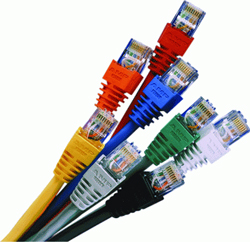Early in your business, you needed a robust connection as things were just ramping up on the Internet. Dial-up was too annoying. DSL was too flakey. SONET fiber was just way too expensive and had bandwidth you’d never need. T1 was the right solution at the right time. Always on. Always reliable. Low latency, low jitter and low packet loss. That 1.5 Mbps bandwidth may or may not still be getting the job done, but like all good things, T1 is coming to an end. What to do now?
 It Still Works. Why Get Rid of It?
It Still Works. Why Get Rid of It?T1 lines were based on telephone lines. That is, twisted pair copper wires. That was the genius of the design. The phone companies could install T1 service using the same wiring they already had in place for multi-line business phones. Just about any business could get T1 and many, many did over the decades.
So, why not stick with a winner? Two reasons, really. First, the Internet today isn’t the nascent Internet of the ’90s. E-commerce is pretty much universal. Nearly every business has a website and most take online orders. A lot of businesses are online only. Those that aren’t still need to be connected for credit card verification, inventory control, supplies ordering and customer interaction. High definition graphics and video have supplemented email and text files that dominated early Internet use. A T1 line’s 1.5 Mbps bandwidth is getting to be a limitation for even small business operations.
The other reason is that copper telco lines are something like incandescent light bulbs. They’ve served us well for more than a century, but it’s time for new technology to take over. Phone companies own the copper lines in the ground and on poles. The costs of maintenance are getting too high considering the dwindling number of users. More and more areas of the country are seeing phone company notices that copper service is being discontinued. The replacement is generally fiber optic or, in some cases, wireless broadband.
A Sensible Replacement for T1 Internet
If you need a bandwidth upgrade or find yourself being cut-off from T1 service, you might be interested in an entry-level fiber optic bandwidth service called 10 Mbps Ethernet DIA or Dedicated Internet Access. What you get is 10 Mbps always on bandwidth versus the T1 line limit of 1.5 Mbps. It is also dedicated to your business only, so that you are not sharing this capacity with other companies. That means your speed won’t be varying depending on what others are doing. This is Carrier Ethernet service that is directly compatible with your Local Area Network. Just plug it into your router and go.
Oh, but how much more will you pay for this faster service? Thanks to extensive buildouts and more competition in fiber networks you may not pay any more for 10 Mbps Ethernet DIA than the old T1 contract you’ve kept renewing. Maybe even less.
Fiber Optic Ethernet is Easily Upgradeable
Once you have fiber installed, you should be good to go for the foreseeable future. That’s because the fiber itself has nearly unlimited bandwidth. What you are using is determined by the terminal equipment installed in your business and how much you want to pay each month. You may start off with 10 Mbps but then find you really need 50 Mbps or 100 Mbps to support your expanding business. These days Gigabit Ethernet is standard for many companies and more are bringing in 10 Gigabit service. In rare instances with unusually high Internet demand even 100 Gbps makes sense.
Typically the provider will install a GigE or 10 GigE port for your service. You can then order up to 1 Gigabit with the GigE port or 10 Gigabits with the 10 GigE port. Many providers will give you an online account that lets you change your bandwidth at will. You’ll automatically get billed for the higher rate when you upgrade. Unlike the old SONET days, upgrading bandwidth won’t generally require a truck roll and change of terminal equipment at your site. You can make the speed increase yourself almost instantly.
Private Lines Also
Ethernet over Fiber offers private lines as well as Internet access. A private line connects two locations directly and does not use the Internet. That means you are unaffected by Internet congestion or other Internet problems. Many businesses are choosing to host their business software in the cloud rather than run their own data centers on-site. A dedicated private line from your location to your cloud service provider, called a direct connection, helps to make the system run smoothly without lags and cutouts.
Are you ready for or in-need of a replacement for your aging T1 Internet line? If so, check competitive pricing on 10 Mbps and higher Ethernet over Fiber service now.

